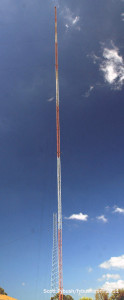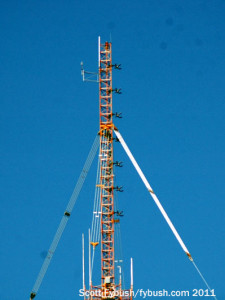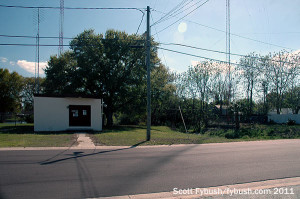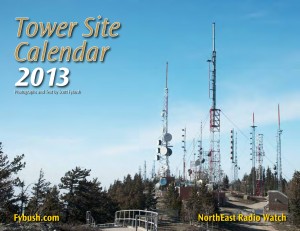NorthEast Radio Watch 12/8/2025: Cichon’s Back in Buffalo
In this week’s issue… Veteran newsman returns - Remembering NY's Leitner, RI's Jones - CT AM saved - Maine AM moves - "Indie" adds suburban signals
Text and photos by SCOTT FYBUSH
If any market got somewhat shortchanged by our “Big Trip 2011,” it was probably Tampa-St. Petersburg. For such a large market, we didn’t schedule much time to drive around and see everything there was to see in and around Tampa Bay, and we’ll definitely have to get back again sometime soon. But we did catch most of the highlights, including the spectacular history in and around the Gandy Causeway that we profiled in our last Tampa installment (and in Tower Site Calendar 2012, too.)
Gandy Causeway, as it turns out, isn’t the only place around Tampa where you can see a “drive-through” directional array – in fact, it’s one of three such sites around the market, all of them over on the Pinellas County (St. Petersburg) side of the bay.

Keep going west from Gandy Causeway and you’ll eventually come to the community of Seminole, Florida, just north of St. Petersburg, and if you make your way into a little neighborhood of newer homes alongside a canal just east of Lake Seminole, you’ll find three towers right there amidst the McMansions.
The towers were there first, of course, but not for the present occupants of the site, WHBO (1040 Pinellas Park) and WXYB (1520 Indian Rocks Beach). This was built back in the mid-1960s as a two-tower site for what was then WFSO (570 Pinellas Park), a 500-watt signal that didn’t get much beyond Pinellas County on a good day. WFSO (the calls stood for Five-Seven-Oh) eventually became WPLP, the first all-talk station in the market, operating from studios in what was then a rather remote, swampy site. (The old concrete-block building still stands here, behind an elevated transmitter building.)

In later years, 570 boosted power with the addition of a third tower between the original two – and eventually, around 1984, the signal was moved away from here to a new six-tower site way up at the northern end of the market in Odessa, Florida, where it’s now Salem’s WTBN, running 5000 watts day and night.
We didn’t get up there, but we did spend some time in the old WFSO/WPLP tower field, where houses now butt right up against the bases of what’s left of the old 570 array. You may need a scorecard here: after 570 moved away, this became the new home of WHBO, which had started out as a 250-watt country daytimer on 1050. The breakdown of the clear channels allowed WHBO to move to 1040 and take over the old 570 array, eventually adding a fourth tower at the north end of the three-tower array to reconfigure its nighttime directional pattern for a little more juice over Tampa.
Still later, WXYB (1520) moved here from its original 1960s-era site just to the south on Park Boulevard, initially using the one former WFSO/WPLP tower that WHBO didn’t use. And then, in 2006, workers building more homes in the area sliced a guy wire that sent the middle tower toppling. That resulted in a long-running STA while WHBO’s owners have negotiated with city officials and the owners of the land to try (and thus far fail) to get that tower rebuilt. Today, WHBO uses the northern tall tower by day and adds the short northernmost tower at night, while WXYB uses the southern tall tower for its day and night operations.
(There’s an FM site over this way that we missed: WYUU 92.5 Safety Harbor and WSJT 98.7 Holmes Beach share a tower off Park Boulevard, and while we missed them, Mike Fitzpatrick caught up with them later in 2011 for NECRAT.us.)
Speaking of Safety Harbor, that small town sits on one side of its eponymous inlet at the north end of Old Tampa Bay, up to the northeast of these Seminole sites. At the other end of the little causeway across Safety Harbor is the town of Oldsmar – and it’s there that we find a neat mix of AM and FM sites.
Coming over the causeway that crosses Safety Harbor heading east into Oldsmar, we see two fairly tall FM towers and a third shorter tower off in the distance, and upon closer inspection we find that only one of them (the center one, as seen in the view above) still has a live FM station on it. That’s Cox’s WXGL (107.3 St. Petersburg), which started out in the 1960s as WPIN-FM, paired with what was then WPIN (680 St. Petersburg). Those stations rose to fame as beautiful-music WWBA/WWBA-FM beginning in the late 1960s before splitting up in the 1970s. The other tall tower over here used to be home to stations on 97.9 and 100.7, now WXTB and WMTX, and we’ll catch up with both of them later on.
Just to the north of the tall FM towers is a site with six AM towers shared by two Clear Channel AM stations, WFLA (970 Tampa) and WHNZ (1250 Tampa). Both stations moved around quite a bit before they got here in 1976 and 1999, respectively. In our last installment, we explored the early chapters of the WFLA story, when it shared 620 with WSUN.

WFLA split off from that share-time arrangement in 1940, moving to 940 and then to 970 from a site on the east side of Tampa Bay at Rocky Point, where it remained until moving up here to Oldsmar in 1976 to make room for a new hotel at the Rocky Point site. A sixth tower was added to the site when 1250 moved here from its former site at Egypt Lake (later used by WTMP 1150). Back then, 1250 still used its heritage calls of WDAE – a callsign that, just to complete the circle, landed down at 620 on the dial, the old WSUN that shared time with WFLA back in the day. (The WHNZ calls and format, in turn, had moved up the dial from 570.)
Want one more drive-thru AM array? We’ve got it, back on the Safety Harbor side of Safety Harbor, where we find Salem talker WGUL (860 Dunedin).
This started out as Clearwater-licensed daytimer WAZE back in 1959, eventually becoming Spanish-language WAMA before that callsign and format shifted across the bay to the Tampa-licensed signal at 1550. The WGUL calls had belonged to the daytimer on 1500 in nearby New Port Richey (now WPSO) and its sister FM, today’s WDUV (105.5). As WGUL, 860 managed to boost its daytime signal to 5,000 watts by buying out the former WKKO 860 across the state in Cocoa and taking it dark; at night, WGUL runs 1500 watts from these three towers tucked into an office park, one north of Harbor Lake Drive and the other two to the south.
WGUL isn’t the only AM on this side of the bay to boost power in recent years. Remember the WWBA calls that started out on 680 and 107.3? They later landed on 1040 and then, eventually, on the Largo-licensed station at 820. Back in the days when that clear channel was sacrosanct, the station in Largo started out in 1972 as WSST, an 500-watt daytimer at 800 on the dial. The breakdown of the clear channels allowed it to move to 820 (as “Radio Florida, WRFA”) with a five-tower array at the old 800 site (to this day, it still bears the “800” sign out front, which is also its street address on 8th Avenue SE); nowadays, it carries a talk format that’s never quite caught fire against the bigger guns in town.
For our final site up here on the north side of the market, we go way up into Pasco County, where we find two tall towers that were built to solve some pesky spacing issues.
Channel 10 was the latecomer to the Tampa Bay VHF dial, signing on in 1965 as Largo-licensed ABC affiliate WLCY-TV, more than a decade behind the debuts of NBC outlet WFLA-TV (Channel 8) and CBS affiliate WTVT (Channel 13). Because of short spacing to channel 10 in Miami, WLCY-TV couldn’t use the main Tampa Bay tower farm at Riverview, southeast of Tampa in Hillsborough County, so it built instead up here in Pasco County at Holiday, where its 1537-foot tower sat in what eventually became a suburban neighborhood, with guy-wire anchors interspersed with housing lots. The north-side tower site meant channel 10 was hard to see on the south side of the market, which extends (for TV, anyway) way down into Sarasota, where WXLT (Channel 40, now WWSB) came on in the 1970s as a separate ABC affiliate for that area.
WLCY-TV eventually became WTSP-TV and shifted from ABC to CBS in the great affiliation shuffle of 1995, which sent WTVT to Fox and shifted ABC over to Scripps Howard’s WFTS (Channel 28). It remained at Holiday for the dawn of the DTV era, where its VHF channel (it remained on RF 10) became even more of a liability in a market where whatever antennas existed were mostly aimed across town at Riverview. So in late 2011, WTSP finally moved its digital signal down to Riverview and began dismantling this tower. (NECRAT actually got some shots of that work underway!)
Just to the southwest of the WTSP tower, another very tall stick still stands down at the end of a winding road that leads back from a set of gates in another residential neighborhood. This 1528-footer is home to three FMs that also can’t quite fit at the Riverview tower farm, or even (as full class Cs, anyway) at any of the FM sites closer to the bay. It’s home to Clear Channel’s WXTB (97.9 Clearwater), which built the tower in the 1990s to retain full class C height as it moved north from Oldsmar (and from an earlier site before that in Seminole, just east of the 570/1040/1520 site that started this week); later on, it also became home to two Cox stations. WDUV (105.5 New Port Richey) is the former class A WPSO-FM that got a huge upgrade to 33kW as a C1 after a co-channel station in Sarasota was moved to 104.3. And at 97.1 on the dial is a station that started out as WLVU-FM, a class A on 106.3 licensed to Holiday. A frequency swap with another signal even further north allowed the Holiday station to become a C2 on 97.1, reaching at least the northern half of the Tampa Bay market – where it now does rock as “97X,” hiding the WSUN callsign that’s seen so much history in and around Tampa Bay over the decades.
Thanks to Cox’s Ed Allen for the tour!
 It’s 2013! Do you have your Tower Site Calendar 2013 yet? We’ve still got some left, and they’re shipping right away from the all new Fybush.com store! Order now and your wall can be festooned with Florida and much more all through 2013. (We’ve also got the very last FM Atlas copies available for sale, and the new edition of the National Radio Club’s AM Log.)
It’s 2013! Do you have your Tower Site Calendar 2013 yet? We’ve still got some left, and they’re shipping right away from the all new Fybush.com store! Order now and your wall can be festooned with Florida and much more all through 2013. (We’ve also got the very last FM Atlas copies available for sale, and the new edition of the National Radio Club’s AM Log.)
Want access to more than a dozen years’ worth of Tower Site of the Week? All our archives, fully searchable, are available to Fybush.com subscribers – and you get full access to NorthEast Radio Watch, too! Subscriptions start at just $15. Sign up here!
And don’t miss a batch of Orlando IDs next Wednesday, over at our sister site, TopHour.com!
Next week: Tampa, 2011 (part 3)
In this week’s issue… Veteran newsman returns - Remembering NY's Leitner, RI's Jones - CT AM saved - Maine AM moves - "Indie" adds suburban signals
In this week’s issue… Scripps stations face takeover - Sinclair moves more affiliations - CT stations sold - Maine AM surrendered - Remembering WVBR's Shapiro, WABC's Morgan
In this week’s issue… CT TV legend succumbs to cancer - Remembering PA's Adams - FCC still stalled by shutdown - Pittsburgh morning host exits
In this week’s issue… FCC faces reopening challenges - Veteran Boston anchor retires - Morning shift in Toronto - NYC FMs expand reach